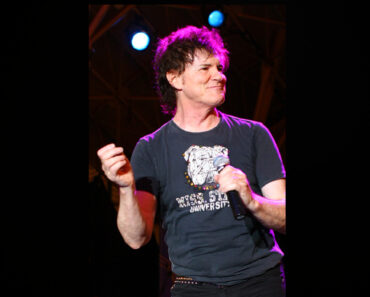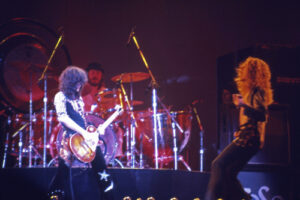
Feature Photo: Glynnis Jones : Shutterstock.com
# 10 – The Soul Cages—Sting
“The Soul Cages,” the title track from Sting’s 1991 album, is a deeply introspective and emotionally charged song. It opens this list as a prime example of how rock music can intertwine complex themes with powerful lyricism. Written as a response to the death of Sting’s father, the song delves into grief, loss, and the feeling of being trapped by life’s emotional burdens. The Soul Cages as an album marked a significant moment in Sting’s career, reflecting both a personal and musical evolution as he grappled with his father’s passing.
Read More: Top 10 Sting Songs
# 9 – Sullen Soul – Maria Mckee
“Sullen Soul,” from Maria McKee’s Peddlin’ Dreams album, is a haunting and introspective track that captures the melancholy and emotional depth McKee is known for. Released in 2005, the album Peddlin’ Dreams finds McKee blending folk, rock, and Americana elements, creating an intimate soundscape that complements her raw and emotive lyrics. Jim Akin’s song stands out as a somber reflection on solitude, aging, and the weight of memory, themes that resonate deeply with listeners.
Read More: 10 Maria McKee Songs That Will Leave You Mesmerized
# 8 – Easy On My Soul – Bad Company / Free
Originally released by Free and written by vocalist Paul Rodgers, “Easy On My Soul” is a soulful and reflective track that captures the emotional depth of both Free and Rodgers’ subsequent band, Bad Company. The song first appeared on Heartbreaker (1973), Free’s final studio album. At this point in Free’s history, the band was in a state of transition following the departure of bassist Andy Fraser and the increasing struggles of guitarist Paul Kossoff, who was battling addiction. These challenges permeated the album’s mood, with “Easy On My Soul” embodying the bittersweet tone that defined Free’s closing chapter.
Read More: Bad Company’s Best Song On Each Of Their Studio Albums
Read More: Top 10 Free Songs
# 7 – Queen – Soul Brother
“Soul Brother” was originally released as the B-side to Queen’s iconic single “Under Pressure” in 1981. While it didn’t initially receive the same widespread attention as the A-side, it has since gained recognition for its intensity and emotional depth, particularly through Freddie Mercury’s powerful vocal performance. Later included in the 2011 reissue of Hot Space as part of a bonus EP, this song is a hidden gem in Queen’s catalog, beloved by dedicated fans for its heartfelt lyrics and the raw energy Mercury brings to the track.
Read More: Brian May of Queen: The ClassicRockHistory.com Interview
# 6 – Soul’s On Fire – Southside Johnny And The Asbury Jukes
“Soul’s On Fire” is a powerful track from Better Days, the 1991 album by Southside Johnny and the Asbury Jukes. Co-written by John Lyon (Southside Johnny) and Steven Van Zandt, the song exemplifies the deeply emotional and soulful connection the band is known for. This track highlights the collaborative spirit between Lyon and Van Zandt, who was a pivotal contributor to the band’s early success, writing several songs for their first three albums. Better Days marked a return to this fruitful collaboration, bringing Van Zandt’s raw songwriting back to the forefront of the Jukes’ sound.
Musically, “Soul’s On Fire” carries all the hallmarks of a classic Southside Johnny song, blending rock, rhythm and blues, and soul. The song is driven by the passionate, gritty vocals of Southside Johnny, accompanied by the robust instrumentation that characterizes the Asbury Jukes. Van Zandt’s contributions are evident in the soulful guitar work and the heartfelt lyrics, which touch on themes of longing, loss, and emotional pain. The song’s production, handled by Van Zandt himself, captures the essence of the Asbury Jukes’ live energy, making it a standout track on the album.
Read More: Top 10 Southside Johnny Songs
# 5 – Club Soul City – Gary U.S. Bonds
“Club Soul City” is a standout track from On the Line, the 1982 album by Gary U.S. Bonds, which marked his continued collaboration with Bruce Springsteen and the E Street Band. Released as part of Bonds’ resurgence in the early ’80s, this album followed the success of Dedication and saw many key E Street Band members lending their talents to create a distinctive rock and soul fusion. Springsteen, who wrote many of the album’s tracks, including “Club Soul City,” played an instrumental role in shaping its sound. The track embodies a spirited, upbeat atmosphere, filled with the kind of soulful energy that typifies much of Bonds’ work.
Read More:
# 4 – Soul Dance Number Three – Wilson Pickett
“Soul Dance Number Three” by Wilson Pickett is a dynamic and infectious track that stands as one of the highlights from The Sound of Wilson Pickett album, released in July 1967. Written by Pickett and renowned producer Jerry Wexler, this song epitomizes the high-energy soul music that made Pickett a household name. Recorded at FAME Studios in Muscle Shoals, Alabama, under the expert production of Rick Hall, Tom Dowd, and Wexler, this track bursts with rhythm, groove, and pure soul power.
Musically, “Soul Dance Number Three” is driven by the tight, syncopated drumming of Roger Hawkins and the electrifying lead guitar work of Chips Moman. Spooner Oldham’s piano and organ lines complement Pickett’s commanding vocals, creating a rich, layered sound that defines this era of soul. The Muscle Shoals Horns, led by Wayne Jackson on trumpet and supported by saxophonists Andrew Love, Charles Chalmers, and Floyd Newman, add a vibrant brass section that elevates the dance energy of the track.
Read More: Top 10 Wilson Pickett Songs
# 3 – Monkey In Your Soul – Steely Dan
“Monkey in Your Soul” is the closing track on Steely Dan’s Pretzel Logic, an album that exemplifies the band’s sophisticated fusion of rock, jazz, and funk. Released on February 20, 1974, this track underscores Steely Dan’s knack for blending complex musical arrangements with sharp, often cryptic lyricism. Written primarily by the band’s core members, Donald Fagen and Walter Becker, the song features contributions from several prominent studio musicians in Los Angeles, including Jeff Porcaro on drums and Jeff “Skunk” Baxter on guitar. It was recorded at The Village Recorder in West Los Angeles and produced by long-time collaborator Gary Katz.
Read More: Steely Dan’s Best Song On Each Of Their Studio Albums
# 2 – Soul Sacrifice – Santana
“Soul Sacrifice” by Santana is a landmark track epitomizing the energy and fusion of Latin, rock, and jazz for which the band became famous. Featured as the closing track on their 1969 debut album Santana, the song gained legendary status after Santana’s electrifying performance at Woodstock. The band, largely unknown at the time, delivered a powerful and memorable set, with “Soul Sacrifice” standing out as a high-energy piece showcasing Carlos Santana’s blistering guitar work and the band’s distinctive use of percussion, led by drummer Michael Shrieve. This performance, immortalized in the Woodstock documentary, is often credited with catapulting Santana into the global spotlight almost overnight.
Read More: Top 10 Santana Songs
# 1 – Mr. Soul – Buffalo Springfield
“Mr. Soul” by Buffalo Springfield, written by Neil Young, stands as a poignant reflection on the pressures of fame and the existential weight that comes with being thrust into the spotlight. As the closing song on this list of standout rock songs with the word “soul” in the title, “Mr. Soul” offers a deep and introspective end, capturing both the personal struggles of Young and the broader human experience of grappling with identity and change. Released in 1967 as the B-side to “Bluebird” and featured on Buffalo Springfield Again, the song quickly became a staple in Buffalo Springfield’s catalog, showcasing Young’s distinct songwriting and introspective approach to rock.
Read More: Top 10 Buffalo Springfield Songs













































